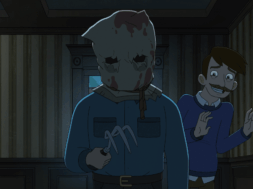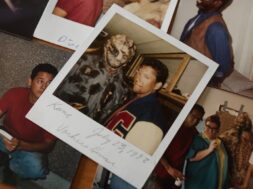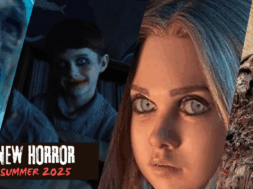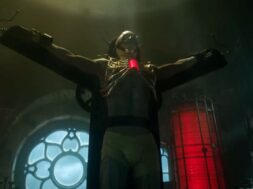Each month in Horror Queers, Joe and Trace tackle a horror film with LGBTQ+ themes, a high camp quotient or both. For lifelong queer horror fans like us, there’s as much value in serious discussions about representation as there is in reading a ridiculously silly/fun horror film with a YAS KWEEN mentality. Just know that at no point will we be getting Babashook.
As two gay men, we have opted to use the moniker “Horror Queers” for this series of articles. It is a word that has a complicated history due to its derogatory use by bullies and hateful people, but has increasingly been adopted as a term of empowerment and a unifying term that recognizes the many complex identities that make up the LGBTIQQ community. Queer has become commonplace in academia, politics and pop culture over the past three decades. We understand and recognize that the term is still very hurtful for some people, but we believe that the more people that proudly reclaim it, the more the wounds and stigma surrounding the term are reduced. Using the word “queer” is intensely personal, but it is a decision that we are committed to. Please don’t be an asshole when using it and we’ll get along fine.
***SPOILERS for Batman Returns to follow.***
Synopsis for Batman: The monstrous Penguin (Danny DeVito), who lives in the sewers beneath Gotham, joins up with wicked shock-headed businessman Max Shreck (Christopher Walken) to topple the Batman (Michael Keaton) once and for all. But when Shreck’s timid assistant, Selina Kyle (Michelle Pfeiffer), finds out, and Shreck tries to kill her, she is transformed into the sexy Catwoman. She teams up with the Penguin and Shreck to destroy Batman, but sparks fly unexpectedly when she confronts the caped crusader.
Queer Aspect: The film contains a multitude of superhero “secret identity” tropes that mirror the repression/coming out process of queer folks. Oh and Catwoman is a goddamn boss.
Joe
Ahhh Trace, I’m so excited that you suggested we end our first year of Horror Queers with this unorthodox (but completely appropriate) suggestion! Not only are superhero properties rife for queer examination, Batman Returns is just such a GREAT, iconic film. Plus: this rewatch really did confirm that it’s chock full of content for us to discuss, which naturally includes Michelle Pfeiffer’s career-defining role as Selina Kyle/Catwoman (I’m sure we’ll undoubtedly get to the icky real-world parallels between Danny DeVito’s The Penguin’s run for Mayor and a certain political figure in due time, but for now, let’s stay in the comfort of skin-tight BDSM leather outfits that have inspired countless slutty gay Halloween costumes, shall we?)

I’m not sure about you, but Batman was a seminal figure of my childhood: the 1989 film is one of the first films I can remember seeing in theatres with my parents and I became so obsessed with Returns that I made my father drive to every single McDonalds in town so that I could collect the commemorative promotional tie-in cups. Naturally, the one I coveted the most was the Selina Kyle/Catwoman cup (shocking, I know).
Now…I’m going to start this analysis with the Debbie Downer bit and then end on a high note. I’ve rewritten this initial section three or four times, but it took this rewatch for me realize that Catwoman – as an historical character, but more specifically as a “villain” in this film – is problematic.
She embodies the classical Hollywood dichotomy of virgin/whore that female characters tend to be boxed into: she’s “bad” because she’s a thief, but her narrative has a redemptive arc which confirms that, deep down, she’s a “good” person. Just like the female protagonists of 50s melodramas or the femme fatales in film noirs, Catwoman/Selina Kyle is a “bad” woman only in the sense that she needs to be “rescued” by Batman/Bruce Wayne and returned to normalcy by the time that the credits roll. Sure, she gets to rebel, act out, cause property damage, and fake swallow a bird, but the reality is that it’s nothing more than lip service. Catwoman’s turn at villainy is essentially just a delay tactic until the bad girl is redeemed by the hero at the end of the film.
Screenwriter Daniel Waters wants to pretend that Catwoman is a liminal figure who straddles the hero/villain line, but there’s never a doubt that Catwoman is different from the Penguin and Max Shreck (the film’s true villain). It’s a little frustrating – and reductive – that the film’s most energizing performance isn’t allowed to be truly villainous or that the lone female character of note is also required to act as the love interest.
Yes, it’s bred into the character’s historical (comic) DNA, but wouldn’t it have been nice to free Catwoman from the shackles of convention and just let her be bad? Perhaps this was too daring an idea and I’m being unreasonable for 1992.*
*But not really, because the same fate basically befalls Uma Thurman’s Poison Ivy in Batman & Robin and arguably there’s no attempt to even pretend that Catwoman is bad in Nolan’s The Dark Knight Returns.
Regardless of the gender politics of the character, though, there’s something indelibly captivating about Catwoman in Batman Returns, which I credit 1000% to Pfeiffer. Character criticism aside, I need to take a moment to bow down to Pfeiffer for her performance in this film because it is truly one for the ages! For me, her prance through the Shreck department store, casually whipping the heads off of mannequins, before backflipping down the street and announcing herself to Batman and the Penguin with a sultry “Meow” is sheer perfection.
Credit Costume Designers Bob Ringwood and Mary E. Vogt, too, for crafting one of the most iconic comic book looks of all time. Is there a chance in hell that that skin-tight lewk was sewn on a home sewing machine? No. Do I care? Not at all.
But Trace, I feel like I’m hogging the mic. This was your pick and I know you want to discuss all things Catwoman, so I’ll concede the floor to you. Did you select Batman Returns primarily for her, or did the camp aesthetic play into your decision? Also: we’ve got to spend time on Walken’s and DeVito’s respective manic performances!
Trace
It’s so funny to me that McDonald’s had promotional tie-ins for Batman Returns. Obviously, the Batman property is all about merch, but Batman Returns is so not a children’s movie. This is some dark shit and I can’t believe Burton got away with making it. Batman Returns is a sublime piece of Gothic horror that was, unfortunately, yet understandably, condemned for being just that upon its release in 1992. It has attracted a sizable cult following over the last 26(!) years, however, so we can at least take pleasure in that. Also, it is the best Christmas movie. Gremlins and Die Hard be damned.
Tim Burton’s Batman was released the year I was born, so I was a little too young to get into the character’s first film incarnation. I actually think the first Batman movie I ever saw was Batman Forever. My introduction to the character, though, was in the superb (and also somewhat too-dark-for-children) Batman: The Animated Series. My mother had seen Batman Returns upon its initial release and hated it (the only scene she could remember was the Penguin eating a fish and then biting someone’s nose….I guess that was the line that couldn’t be crossed with her). When I was around eight or so, I asked to watch the first Batman. So clouded was my mother’s mind by the inappropriateness of Batman Returns that she refused to even let me watch the original. Though to be fair: I don’t think Batman ‘89 is that child-friendly either. Not because it’s too dark, but rather that it’s much more of a slow burn. I find it difficult to believe that a child would find it particularly entertaining (I found it to be extremely boring when I finally got around to seeing it when I was 10, but maybe that’s just me).
My mother finally (finally) let me watch Batman Returns when I was 13 and I absolutely loved it. Maybe it was because I considered the film taboo since I was prevented from seeing it for so long. Or maybe it was because deep down I recognized the queer themes and connected to so much of the film. Or maybe I just loved Pfeiffer’s performance. It’s difficult to say, but I love the film so much that I consider it the best of the Batman films (yes, even better than any of Christopher Nolan’s films). Is it true to the comics? Apparently not (I’ve never read them), but taken as a film on its own terms, it’s excellent.

But enough about me, let’s move on to Catwoman herself. She has long been one of Batman’s most interesting villains (I’m partial to Poison Ivy, but Catwoman is a close second). I can’t speak to how she is written in the comics, but I attribute most of the character’s popularity to the actresses that have portrayed her in live-action roles. Julie Newmar, Lee Meriwether and Eartha Kitt all stood out in the 1960s television series for their gloriously campy portrayals (Kitt’s more than anyone else’s, but they’re all great). Michelle Pfeiffer gave us what is probably the most iconic incarnation of the character (which is surprising considering she is the least like her comic book counterpart). Halle Berry’s Catwoman is….a thing that exists. And I maintain that Anne Hathaway’s Catwoman is the best part of Nolan’s drab The Dark Knight Rises (seriously, she is the only person in that movie who looks like she is even moderately enjoying herself). Pfeiffer reigns supreme, though. She is perfection in Batman Returns and I will forever be pissed that a solo Catwoman film with her never materialized, especially considering the cliffhanger at the end of Returns!
To your point: I most certainly don’t view Catwoman (as portrayed in Batman Returns) as problematic, and how dare you say that she is! I’ll let you have the whole “the lone female character of note is also required to act as the love interest” thing, even though the dichotomy between Batman and Catwoman has long been a defining point of their relationship. Yes, Batman does help Catwoman along her journey, as does Bruce with Selina (who share some of the best scenes in the film), but it doesn’t take anything away from her character. Ultimately, she has complete agency over her own arc and she’s the more important character between the two. Hell, I think she even has more screen time than Batman. He is a supporting character in his own movie! It should be called Batman Cameos (I can’t take credit for this joke. I’ve definitely seen it somewhere online but can’t remember where, hence the lack of a proper credit).
You describe Catwoman as a villain, but the more appropriate word to describe her would be antiheroine (at least until that final scene). Yes, she steals things, but she is never the same type of evil that the Penguin is. I think you’re confusing what you think the character *should* be with what the character is and always has been. To my knowledge, Catwoman has always (or at least post-‘80s…which I realize is a big gap since the character made her comics debut in 1940, but whatever) had elements of an antiheroine rather than an outright villain. There has usually been a conflict there. In Batman Returns, Catwoman acts as a direct counterpoint to the Penguin. She represents what happens when a person struggles with their queerness (and/or society’s acceptance of them) and comes out on the side of good (kind of…her swan song is murdering the fuck out of Max Shreck), whereas the Penguin fully embraces his queerness and becomes a force of pure evil while still being a somewhat sympathetic villain.
Speaking of, we haven’t really gotten into the Penguin. Catwoman is clearly a metaphor for the coming-out process, but what does the Penguin represent? Is he, like I suggest above, representative of the ostracization that queer people feel after they have come out? To bounce off of your controversial statement with a slightly less controversial one: is the Penguin problematic? This is a decidedly queer character who is made to be the villain, but his villainy rises out of society’s (and, more specifically, his parents’) refusal to accept him. Should we be offended that this completely queer character is also fucking disgusting? I guess we can take solace in the fact that he clearly doesn’t have any body image issues, right? Walken’s role is less interesting (to me, at least), but by all means comment on that if you’d like.
Oh! On a less important note: would the film work nearly as well without Pfeiffer? Imagine if Annette Bening hadn’t dropped out of the role due to her pregnancy. Or imagine if, god forbid, Sean Young had actually been cast.
Joe
Oh wow. I knew that other actresses were considered (there’s always a shortlist) but it’s nearly impossible to think of either of them in the role. I’m sure Bening would have done something interesting, though I have difficulty seeing her in the same sensuous way (my only knowledge of Young is in Bladerunner and Rachel is decidedly…flat).
Also: just to ensure that everyone correctly understands my argument, I’m not suggesting that Pfeiffer’s Catwoman (performance) is problematic; rather I wish that her entire narrative arc wasn’t all about Max Shreck or Bruce Wayne. Yes, the revenge plotline allows her to take glorious agency and her tete-a-tete with Bruce (particularly on the dance floor at the ball where the masks literally come off) is my favourite scene of the entire film, but dammit I want more for her! I just lament that the Penguin gets to do his own political narrative simply because he wants power (more on that in a moment). More than ever, from this privileged 2018 position, I want a storyline for Catwoman where she just gets to be her own badass self instead of being indentured to men.
Perhaps this speaks to my biggest criticism of Batman Returns: its overstuffed narrative. Whether you see Catwoman as a villain or an antiheroine, there’s a lot of moving parts in this movie and sometimes it seems like no one gets quite the attention that they deserve – certainly not the same way that Nicholson did as the Joker in the original. Chalk that up to old Jack’s star power back then (he is top-billed over Keaton) and the fact that the Joker is the most significant villain in Batman’s oeuvre, but the sequel overcompensates by adding not just Penguin, not just Catwoman, but also Shreck. It’s a lot of carnival juggling, even if the circus is in town.

So let’s get to the Penguin. A little boy that doesn’t turn out quite as his parents expected, gets tossed aside to save face, then tries to make something of himself despite all odds. Instead, he gets taken advantage of by a conniving imposter father figure who dolls him up and parades him around town as something he’s not. Then when the misunderstood man ultimately figures out who he is, he tries to burn the fucking establishment down (via missile-launching birds) and dies. Yup…sounds like every 90s gay narrative to me!
In all seriousness though, it’s not hard to see how and why this movie resonates so strongly with the weirdos and the outsiders. It’s basically just a parade of freaks – including Shreck and the carnies – directed by Burton at his most commercially-minded (before he sold out and started making high octane, empty calorie blockbusters). Probably the most normal character, outside of Alfred, is that damn space cadet Ice Princess and she barely survives a few scenes before she gets tossed off a building. This is literally a movie whose narrative repeatedly reiterates that “normal people need not apply.”
In that regard, it’s a bit celebratory. But, yeah, if we consider the Penguin as the embodiment of queer in this film, there is a bit of a “queer villain to be punished” angle to him. But, like your refrain to my Catwoman point (and as you suggested), even the Penguin isn’t a true villain: he’s more of a pathetic, misunderstood figure. As I said up top, Shreck is the real villain, which is probably why outside of Walken’s ah-mah-zing wig and campy performance there’s actually not that much of interest in him. He’s just the man behind the curtain: pushing secretaries out windows, capitalizing on opportunities to run figure-head political campaigns and ensuring his talentless Donald Trump Jr-esque son is taken care of.
Sidebar: what is it with women falling off buildings in this movie?
Trace, I’ll kick it back to you to finish up (this piece & 2018!): what’s your take on Penguin? How does Batman Returns fit into Burton’s weirdness oeuvre? And don’t you secretly wish that we could find a creative way to classify Berry’s Catwoman as a horror film so that we can talk about that campy mess?

Trace
Oh Joe, you just introduced the word “privileged” to our conversation. You know how some of our readers feel about that word! #Triggered.
Anyway, I understand what you’re saying about Catwoman. I’m just saying you’re wrong, at least with regard to her villain arc. Batman doesn’t save her. She chooses villainy over redemption. Sure, her whole character arc involves Batman, Bruce and Max, but it doesn’t revolve around them, and there’s a difference. There’s a difference…There’s a difference.
Regarding the Penguin: sure, he’s a misunderstood pathetic figure, but he is a villain. He tries to murder all of Gotham’s first-born children and when that fails, he then tries to blow up Gotham with the aforementioned missile-launching birds (they’re so cute though, aren’t they?)!
There’s a lot of potential blood on Penguin’s hands (and actual blood, since he does kill quite a few people on top of biting off a nose), but Catwoman doesn’t have that “problem.” The only person she murders is Max. She even shows some semblance of regret when the Ice Princess dies. It is her decision to murder Max that cements her fate as a villain. So really, Batman Returns can be seen as Catwoman’s transformation into a full-fledged villain (or, metaphorically, a big ol’ lesbian).
The most common complaint with Batman Returns (besides its overtly dark tone) has been its overstuffed narrative, and I can’t really disagree with that. Both Batman and Batman Returns are 126 minutes long, but while Batman juggles two characters’ narratives (I’m leaving out Vicki Vale because she doesn’t have much of an arc in that film), Batman Returns juggles four.
The Penguin is granted much more screen time than Catwoman, but that’s mostly because her struggle is an internal one. The Penguin’s internal struggle happens off screen in the years between his abandonment and the start of the film. During the film, his struggle is completely external, materializing in his mayoral campaign and his subsequent attempt to murder a bunch of children.
Catwoman’s internal struggle is simply (or rather, not-so-simply) a woman trying to figure out who she is and where she fits in the world. Catwoman’s arc plays second fiddle, which is lamentable. Her big “coming out” scene, in which she tears up her apartment, destroying her childhood belongings (much like how coming out effectively ends your childhood innocence) and diving into the world of BDSM is one of the film’s most potent moments. Combined with everything else going on in the film, it is a lot.

Speaking of the film being overstuffed, would you believe that Shreck wasn’t in the original screenplay? His death was, though! In one of the original drafts, Catwoman kisses Harvey Dent (played by Billy Dee Williams in Batman) with a taser at the end of the film, thereby turning him into Two-Face. That was scrapped when Williams opted not to return for what was essentially a cameo and the character of Max Shreck, who is not in the comics, was created. This may have been a huge mistake for Williams, as he was replaced by Tommy Lee Jones in 1995’s Batman Forever. I use the phrase “may have” because that depends entirely on your appreciation of Batman Forever. Perhaps Dent’s involvement would have made the film seem less crowded since Two-Face is less of a throwaway character than Shreck? Who knows?
Truth be told, the whole mayoral election subplot is my least favorite part of the film (though it should be noted that this subplot was taken from two episodes of the 1960s TV series). I can suspend a lot of disbelief, but you cannot convince me that anyone in Gotham City would vote for this guy to be their mayor. I’ll let believability slide since it’s such an over-the-top film, but it’s just not a particularly interesting subplot, especially when the Catwoman material is sidelined as a result. The film picks up steam again when the Penguin and Catwoman team up (their initial meeting is glorious and filled with disturbing sexual tension and sounds of leather), but that is extremely short-lived as they “break up” mere scenes later. What I’m trying to say is, the film needs more Catwoman, but enough of my jizz-fest over the character.
Batman Returns is a weird movie, but is it Burton’s weirdest film? My gut wants to say it’s either Pee-Wee’s Big Adventure or even Beetlejuice, but I choose Batman Returns because of what he does (and changes) with pre-established characters who have a long history of very specific characteristics in comics and a television series. How did Burton get away with this? I mean, I know how. Burton wouldn’t come back unless he had total creative control and Warner Bros (Stupidly? Wisely? You decide.) gave it to him. Would it shock you to know that the screenplay was written by one Daniel Waters, aka the screenwriter of Heathers? That certainly adds another layer of queerness to the proceedings, doesn’t it?
As for Berry’s Catwoman, would you absolutely loathe me if I said I didn’t hate it? Don’t get me wrong. It’s not good, but it’s not the train wreck I was expecting it to be when I saw it…in theaters. It’s been a hot minute though, so perhaps I’m due for a rewatch.
Well Joe, so ends our discussion of Batman Returns, as well as our articles for 2018. It’s been a fun run, and I hope our readers (however many there are) have enjoyed reading these as much as we’ve enjoyed writing them. Here’s to a fantastic 2019!
Next time on Horror Queers: We’re starting off the new year with a scream, literally, as we tackle that Wes Carpenter flick, Scream…in multiple formats. Stay tuned for some big news in 2019 as we celebrate our 1-year anniversary!
Batman Returns is available to stream for $3.99 on Amazon Prime. Or just buy the Blu-Ray for $11.90 because it’s awesome.
And don’t forget to catch up on our previous Horror Queers articles here!










